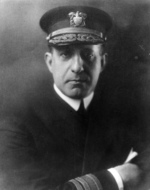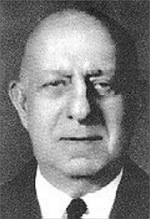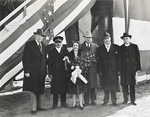Frederic Harris
| Surname | Harris |
| Given Name | Frederic |
| Born | 10 Apr 1875 |
| Died | 20 Jul 1949 |
| Country | United States |
| Category | Commerce-Industry |
| Gender | Male |
Contributor: David Stubblebine
ww2dbaseIn Collaboration With: Andy Werback
ww2dbaseFrederic Robert Harris was born April 10, 1875 to parents who had settled in New York City after moving from England in 1849. In 1896, Harris graduated from the Stevens Institute of Technology in Hoboken, New Jersey, United States with an engineering degree. He took jobs with firms specializing in harbor improvements such as wharves, piers, sea walls, canals, and dry docks. Between 1902 and 1903, Harris joined the team of engineers designing the new Navy Yard at Charleston, South Carolina, United States. This experience introduced Harris to the Navy and in 1903, he enlisted. He was appointed Lieutenant (junior grade) in the Navy Civil Engineering Corps (CEC).
ww2dbaseWith Harris's experience in marine construction, plus his natural abilities, he quickly received assignments with increasing levels of responsibility. After a period at the New York Navy Yard, his was assigned to return to the Navy Yard at Charleston, South Carolina where a new dry dock was being built. This assignment was tailor-made for Harris since he had been part of the design team for the yard itself and he understood the existing improvements in a way that allowed him to perform brilliantly in this assignment. After a promotion to full-Lieutenant, Harris got a lot of attention in 1903 when he bucked the longstanding understandings between the Navy and its contractors. As principal assistant in charge of construction for the Charleston dry dock, he refused to accept a contractor's use of below-standard materials. The contractor threatened to pull strings and have Harris transferred to some distant location, but Harris stood firm for what he knew was right. Harris's transfer orders, indeed, came through but for as long as he remained at Charleston, he still refused to accept delivery of sub-grade materials. News of the face-off spread through Navy circles until the matter was resolved by President Theodore Roosevelt himself. The transfer orders were rescinded and the contracting company backed down. In the end, the dry dock was built correctly and served the Navy for decades to come.
ww2dbaseHarris remained at Charleston for three more years, designing piers, quays, railroad tracks, sewers, a water system, and industrial shops and also overseeing their construction. In 1906, the Navy transferred Harris to the Naval Station at Guantanamo, Cuba where he was given charge of constructing a strategically important naval coaling station. His design work in Cuba also included a masonry dry dock, a target range, and the base's water supply system.
ww2dbaseAfter a year in Cuba, Lieutenant Harris became assistant to the Chief of the Bureau of Yards and Docks, Rear Admiral Richard C. Hollyday, a noted expert on dry docks. After two years in Washington, Harris was assigned to return to the New York Navy Yard in late 1909. The New York Navy Yard had been trying for several years to complete their larger Dry Dock No. 4. Two different contractors had abandoned their contracts part way through because they could not master the shifting sands beneath the Navy yard. The project had become known as the "Beast of Brooklyn" and the "Hoodoo Dock" out of a sense that it was cursed. Because of the dry dock's strategic importance, the Secretary of the Navy assigned the project to the 34-year-old Lieutenant Frederic R. Harris. Harris moved swiftly. The first contractor to fail had tried using steel casements and the second timber, but Harris knew the Beast of Brooklyn's shifting sands could only be tamed by concrete. Harris, in collaboration with the job's third contractor, recommended concrete caissons to be sunk under compressed air. Harris also redesigned the dock's floor using reinforced concrete to compensate for the instability below. Using these novel approaches, the dry dock was successfully completed in 1912.
ww2dbaseLieutenant Harris was fast becoming a leading marine engineering expert with spreading associations in the field. He was even interviewed several times as a maritime expert after the sinking of the Titanic. He solved another major dry dock construction problem at Pearl Harbor, Hawaii using an innovative method that all the "experts" said would not work. Harris later received a patent for that process.
ww2dbaseOn 1 Jul 1913, Harris was promoted to Lieutenant Commander. He continued completing assignments for the Navy with confidence, competence, and dispatch. In finding ways to complete difficult projects, he came to the attention of the right people. A Brooklyn congressional delegation strongly advocated for Harris, a mid-level officer in the Navy's engineering corps, to be appointed as the next Chief of the Navy's Bureau of Yards and Docks.
ww2dbaseUpon the retirement of Hollyday's successor, Rear Admiral Homer Stanford, President Woodrow Wilson indeed appointed Frederic Harris to that Bureau Chief post on 17 Jan 1916. With that appointment, Harris's rank jumped from Lieutenant Commander to Rear Admiral, skipping over the grades of Commander and Captain altogether. Traditionally, the Bureau Chief of Yards and Docks was the ranking member among the five Navy bureau chiefs. Thus, at age 41, Harris was not only the Navy's youngest admiral, he was the second most influential person in the Navy, second only to Chief of Naval Operations Admiral William Benson.
ww2dbaseWorld War I in Europe had started over a year earlier and few doubted the United States would enter the war at some point. It was equally well-known that America's involvement would primarily be on land; but those land forces would have to be transported by sea and then supplied by sea. The need to begin preparing formidable marine infrastructure was apparent to all. The responsibility for creating and maintaining that infrastructure, of course, fell to Admiral Frederic Harris.
ww2dbaseHarris now controlled a budget that amounted to fully one-third of the total United States budget for defense, Army and Navy combined. His bureau was responsible for building shipyards, dry docks, shops, submarine bases, air stations, magazines, barracks, storehouse, and a wide variety of waterfront improvements. In particular, the Philadelphia Navy Yard was due for an upgrade and expansion that included a new 1,100-foot-long dry dock. Once that upgrade was completed, the Philadelphia yard became the largest Navy repair facility on the Atlantic coast.
ww2dbaseAdmiral Harris's areas of responsibility continued to widen to the point he was principal consultant to many ventures in the private sector in addition to his Navy duties. One of his largest Navy projects was to create the Army's new troop embarkation center at Hampton Roads, Virginia. Besides numerous barracks and port facilities, this project called on Harris to create four entire towns complete with streets, water supplies, sewer systems, and more.
ww2dbaseIn 1926, Harris served as president of the board of inquiry investigating the disastrous explosion at the Lake Denmark Naval Arsenal in Rockaway Township, New Jersey (now the Picatinny Arsenal). On 10 Jul 1926, lightning struck the arsenal and 600,000 tons of World War I surplus munitions exploded, creating a crater a mile across and demolishing over 90% of the depot's structures. Twenty-one people were killed.
ww2dbaseOn 5 Apr 1927, Admiral Harris retired from the Navy after 24 years of service. For his exemplary service as Chief of the Bureau of Yards and Docks during World War I, Harris was awarded the Navy Cross. Harris spent no time sitting idle after retirement. Very shortly after leaving the Navy, Harris formed his own company of consulting engineers called Frederic R. Harris, Inc. From the beginning, Harris and his staff were swamped with work in a wide assortment of ventures. As before, his firm's focus was with maritime construction and usually on large, complex projects. Dry dock design continued to be a particular area of specialization and many of the largest shipbuilding enterprises in the United States hired Harris to design their dry docks. Always wanting to be addressed within the firm as "The Admiral," Harris continued to be an innovative thinker and was granted patents for many of his ideas. Harris also lectured widely and wrote several authoritative books, including contributions to the engineering sections of the Collier's and World Book encyclopedias.
ww2dbaseOnce the United States entered World War II, Harris did what was asked of him but his real contribution to the war effort came from the things he had done before the war. A strong backbone of ship repair facilities and shipbuilding yards were essential to America's ability to ramp up war production as it did. In particular, the Pearl Harbor dry dock was essential for the repair of battleships damaged in the Japanese air attack of 7 Dec 1941. Many of Harris's earlier patents were for things the country now needed in great numbers. One of his patents for a floating dry dock system became the basis of the Navy's Advanced Base Sectional Dock (ABSD), essential for the timely repairs of battle damage to capital ships in the South Pacific. Harris also engineered an innovative system for transporting large prefabricated dry dock sections through the Panama Canal. His company was contracted to design and build thirteen naval bases and shipyards with all related facilities such as buildings, piers, docks, bulkheads, and laying out all the roads. During the war, the Frederic R. Harris engineering staff swelled from about 20 people to over 600 by 1943.
ww2dbaseFrederic R. Harris, Inc. came out of World War II well-situated for the next chapter in the firm's life. The post-war rebuilding needed engineers and contractors who could think big and then back it up. The Admiral's company was such a firm. Harris landed the contract for upgrading the wartime improvements on the island of Guam that were first completed by the Navy Seabees. This was a huge contract that led Harris's firm to open new offices in San Francisco primarily to administer those operations. During the war, the Panama Canal had proven so vital and yet so vulnerable and Harris was among those who unsuccessfully lobbied for a second canal across Latin America. The location Harris preferred for the new canal was the Isthmus of Tehuantepec in Mexico. Frederic R. Harris, Inc. thrived in the postwar years, as it had during the war, and the company survives today.
ww2dbaseIn addition to Frederic Harris's engineering prowess, he was a life-long collector of items in many eclectic categories. Chief among his collections was his prestigious assortment of rare stamps. The Admiral was among the founding members of the Philatelic Foundation and he spent a term as its chairman. He also had membership in the American Philatelic Society, the Royal Philatelic Society of London, and the Collectors Club of New York. Beyond stamp collecting, Harris was also active in the Presbyterian church, the American Legion, the Masonic order, Union League of Philadelphia, Republican Businessmen, Propeller Club, City Midday and Explorers clubs of New York City, National Sojourners, Westchester County (New York) Tennis Club, the Army, Navy, and University clubs of Washington, DC. In addition to his private pursuits, his professional associations included the American Society of Civil Engineers, the Society of Naval Architects and Marine Engineers, the National Society of Professional Engineers, the Society of American Military Engineers, the United States Naval Institute, and the professional engineering societies in several states.
ww2dbaseFrederic Harris was married to Dena (Sperry) Harris for many years until her death in 1945. Then, in his 70s, Harris married Florence Bennett and stayed with her until his own death on 20 Jul 1949 at the age of 74. Frederic Harris is buried beside his first wife in Arlington National Cemetery, Arlington, Virginia, United States.
ww2dbaseSources:
Admiral Frederic R. Harris and His Legacy; by Frederic R. Harris, Inc.; [1989]
United States Navy
United States National Park Service
Findagrave
The Philatelic Foundation
Wikipedia
Last Major Revision: Apr 2023
Frederic Harris Interactive Map
Photographs
 |  |  |
Frederic Harris Timeline
| 10 Apr 1875 | Frederic Harris was born in New York, New York, United States. |
| 3 Jan 1903 | Frederic R. Harris enlisted in the Navy and was appointed Lieutenant (junior grade) in the Navy Civil Engineering Corps (CEC). |
| 25 Mar 1906 | Navy Lt Frederic R. Harris (CEC) was put in charge of constructing a strategically important naval coaling station at Guantanamo Bay, Cuba. |
| 1 Dec 1909 | United States Navy Chief of the Bureau of Yards and Docks assigned 34-year-old Lt Frederic R. Harris (CEC) to salvage the construction of Brooklyn Navy Yard Drydock No. 4 after two different contractors had tried and failed to built a stable structure in the yard’s substrates of shifting sands. |
| 1 Jul 1913 | Frederic Harris was promoted to the rank of lieutenant commander. |
| 17 Jan 1916 | President Woodrow Wilson appointed Frederic Harris the US Navy Bureau Chief of Yards and Docks. |
| 5 Apr 1927 | Rear Admiral Frederic R. Harris retired from the United States Navy after 24 years of service and entered the private sector. For his exemplary service as Chief of the Bureau of Yards and Docks during World War I, Harris was awarded the Navy Cross. |
| 20 Jul 1949 | Frederic R. Harris died in New York City, New York, United States. He is buried alongside his first wife, Dena (Sperry) Harris, in Arlington National Cemetery, Arlington, Virginia. |
Did you enjoy this article or find this article helpful? If so, please consider supporting us on Patreon. Even $1 per month will go a long way! Thank you. Share this article with your friends: Stay updated with WW2DB: |
- » WW2DB's 19th Anniversary (29 Dec 2023)
- » Looted Painting "Madonna with Child" Returned to Poland (2 Jun 2023)
- » Wreck of USS Mannert L. Abele Found (29 May 2023)
- » Wreck of Montevideo Maru Found (25 Apr 2023)
- » Accidental Detonation of a WW2-Era Bomb in Great Yarmouth (10 Feb 2023)
- » See all news
- » 1,146 biographies
- » 337 events
- » 43,422 timeline entries
- » 1,237 ships
- » 349 aircraft models
- » 207 vehicle models
- » 372 weapon models
- » 123 historical documents
- » 259 facilities
- » 468 book reviews
- » 28,395 photos
- » 432 maps
James Forrestal, Secretary of the Navy, 23 Feb 1945
Please consider supporting us on Patreon. Even $1 a month will go a long way. Thank you!
Or, please support us by purchasing some WW2DB merchandise at TeeSpring, Thank you!